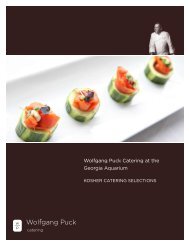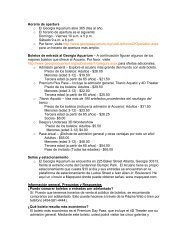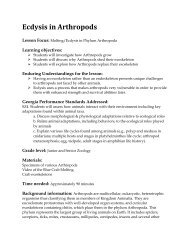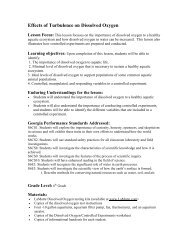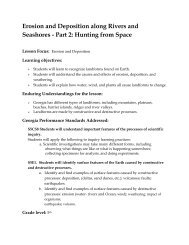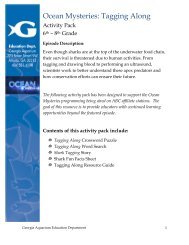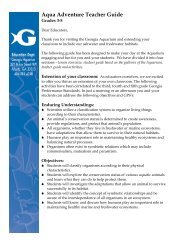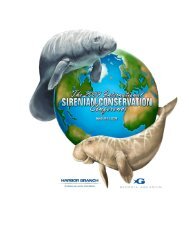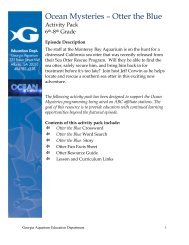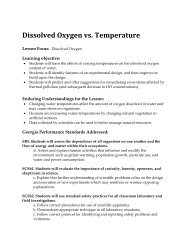GEORGIA AQUARIUM ANIMAL FACT SHEET
GEORGIA AQUARIUM ANIMAL FACT SHEET
GEORGIA AQUARIUM ANIMAL FACT SHEET
You also want an ePaper? Increase the reach of your titles
YUMPU automatically turns print PDFs into web optimized ePapers that Google loves.
<strong>GEORGIA</strong> <strong>AQUARIUM</strong> <strong>ANIMAL</strong> <strong>FACT</strong> <strong>SHEET</strong>Giant grouperEpinephelus lanceolatusRange/Habitat• The giant grouper is a reef-associated, marine or brackish fish.• Its habitat includes shallow reefs, caves, wrecks and estuaries.• It lives in tropical climates from the Red Sea to Algoa Bay, South Africa and eastwardto the Hawaiian Islands, north to southern Japan and south to Australia.Physical Characteristics• The giant grouper grows to a length of eight feet (2.5 meters) and a weight of 660pounds (300 kilograms), but this species has been recorded to reach a length of 9.8feet (3 meters) and weighing more than 882 pounds (400 kilograms).• It has at least seven rows of teeth on the middle of its lower jaw.• The giant grouper’s eyes function effectively in dim light, which gives it an advantageover its prey during dawn and dusk feeding times.• Young giant grouper are bright yellow with large, irregular black or dark brown bars,but these patterns break up as they grow into adulthood as the coloring is a mutedolive.Diet/Feeding• The grouper feeds on fish, sharks and crustaceans, such as spiny lobster.• It is a predator that feeds by ambush, hiding in reefs.Conservation Status• It is listed as Vulnerable in the IUCN Red List of Threatened Animals. This listingmeans that the population of giant grouper is thought to be declining at a rate of 20percent every ten years.• This species is decreasing in population due to overfishing, therefore conservationmeasures have been taken to preserve the giant grouper.Additional Information• Other common names are Queensland grouper and bindle bass.• Groupers start out life as females and later switch sex to male with age. Thismaturation of the grouper classifies it as a protogynous hermaphrodite. It has a latesexual maturity.• It is the largest of all coral reef dwelling bony fishes, though it is a slow-growing, longlivingfish. Grouper are on the upper end of the food chain, so few reside in each areaand few are found on any one reef. Large groupers live to be more than 50 years old,so replacing an older fish in this environment with a younger specimen takes manyyears.• Its mouth is very large and can expand to create a strong suction, which allows it toengulf its unsuspecting prey.
SourcesEncyclopedia of Fishes. 1998, 2 nd Edition, pp. 195-199.Fishes of the Great Barrier Reef. Randall, John E., pg. 109.Fishes of the Tropical Eastern Pacific. Allen, Gerald R., pg. 106.http://www.wwf.org.hk/eng/conservation/wl_trade/reef_fish/why.htmlReefFish. Thresher, Ronald E., pp. 153-155.www.fishbase.org



